Spatial and Temporal Distribution Characteristics of Ozone Concentration and Source Analysis during the COVID-19 Lockdown Period in Shanghai
Abstract
:1. Introduction
2. Materials and Methods
2.1. WRF-CAMx-OSAT Simulation Method
2.2. Emission Inventory during the Lockdown Period
2.3. Social and Economic Statistical Data during the Lockdown Period
3. Results and Discussion
3.1. Model Validation
3.1.1. Evaluation Methods
3.1.2. Evaluation of Meteorological Field Simulation
3.1.3. Simulation Verification of Pollution Field
3.2. Changes and Characteristics of the Emission Inventory during the Lockdown Peri
3.3. Spatial and Temporal Distribution Characteristics of O3 Concentration during the Lockdown Period
3.3.1. Observational Facts
3.3.2. Simulation Results
3.4. Source Apportionment of O3 during the Lockdown Period
3.4.1. Analysis of the Main Contributors to O3 Precursors
3.4.2. Analysis of Sector Source Contribution of O3
3.4.3. Analysis of O3 Regional Contribution
4. Conclusions
- (1)
- During the lockdown period, the air quality in Shanghai showed significant differences compared to non-lockdown periods, the concentrations of most pollutants generally decreased, while the ozone concentration increased. By comparing the PM2.5 and O3 monitoring data for Shanghai from 1 April to 31 May 2022 (a total of 61 days) with the same period in 2021, it was found that the average PM2.5 concentration in Shanghai decreased by 26.8% during this period. However, the MDA8 O3 concentration increased by 14.5%. A total of 49 days had MDA8 O3 concentrations exceeding the first-level concentration limit (100 µg/m³), and 13 days exceeded the prescribed second-level concentration limit (160 µg/m³);
- (2)
- The controlled simulation results of O3 precursors in Shanghai indicate the following: During the simulated period of 2021, the majority of Shanghai’s O3 was primarily influenced by VOCs (volatile organic compounds) in most areas, while in certain suburban counties and rural regions of the city, ozone formation was mainly driven by NOx (nitrogen oxides) control. However, during the simulated period of 2022, the generation of ozone in Shanghai was predominantly driven by VOCs, and the entire area was under VOCs control. Generally speaking, controlling VOCs is an effective approach to reduce O3 concentrations in Shanghai;
- (3)
- A sector source analysis revealed that the transportation sector contributes the most to O3 formation in Shanghai, accounting for 70.61% in 2021 and 64.30% in 2022. Following transportation, the industrial sector also plays a significant role, contributing 20.71% and 26.36% in the respective years. Therefore, controlling emissions from the transportation and industrial sectors should be a priority;
- (4)
- Shanghai’s regional source apportionment results indicate the following: During the months of April and May in 2021, local sources accounted for 58.33% of the contribution to Shanghai’s O3 concentration, while contributions from sources outside the region accounted for 41.67%. The ratio between local sources and transboundary transport was approximately 6:4. In the same period in 2022, local sources contributed to 71.11% of Shanghai’s O3 concentration, while contributions from sources outside the region accounted for 28.89%. The local sources to transboundary transport ratio increased to about 7:3, indicating an elevated contribution from local sources. Locally generated ozone is the primary source of Shanghai’s ozone concentration, and controlling emissions from local sources is the key to managing ozone levels in the Shanghai region;
- (5)
- Different source regions exhibit significant spatial variations in their contributions to the ozone concentration. In 2021, high-contribution regions of local sources to Shanghai’s O3 concentration were mainly concentrated in the southern part of Chongming District, the northern area of Pudong New Area, Jiading District, Baoshan District, the western part of Fengxian District, and the northern and southern parts of Jinshan District. In 2022, high-contribution regions of local sources to Shanghai’s O3 concentration were primarily concentrated in most areas of Chongming Island, Jiading District, Baoshan District, Minhang District, and the northern and central parts of Pudong New Area. Among these high-contribution regions, Chongming District’s high-contribution area exhibited a belt-like distribution, while other high-contribution areas showed a patchy distribution.
Supplementary Materials
Author Contributions
Funding
Data Availability Statement
Conflicts of Interest
References
- Zhang, J.X.; Han, J.J.; Yin, L.; Zheng, J.W.; Gan, Y.N.; Wang, S.G. Study on the Effect of Atmospheric Environment Improvement during Epidemic Control in Major Cities in China. Environ. Monit. China 2022, 38, 123–133. [Google Scholar]
- Hou, X.W.; Zhu, B. Progress of Research on Global Tropospheric Ozone Variation Characteristics during COVID-19 Pandemic. Clim. Environ. Res. 2023, 28, 103–116. [Google Scholar]
- Mills, G.; Hayes, F.; Simpson, D.; Emberson, L.; Norris, D.; Harmens, H.; Bueker, P. Evidence of widespread effects of ozone on crops and (semi-)natural vegetation in Europe (1990–2006) in relation to AOT40-and flux-based risk maps. Glob. Chang. Biol. 2011, 17, 592–613. [Google Scholar] [CrossRef]
- Nuvolone, D.; Petri, D.; Voller, F. The effects of ozone on human health. Env. Sci. Pollut. Res. Int. 2018, 25, 8074–8088. [Google Scholar] [CrossRef]
- Pusede, S.E.; Cohen, R.C. On the observed response of ozone to NOx and VOC reactivity reductions in San Joaquin Valley California 1995–present. Atmos. Chem. Phys. 2012, 12, 8323–8339. [Google Scholar] [CrossRef]
- Zeng, P.; Lyu, X.P.; Guo, H.; Cheng, H.R.; Jiang, F.; Pan, W.Z.; Wang, Z.W.; Liang, S.W.; Hu, Y.Q. Causes of ozone pollution in summer in Wuhan, Central China. Environ. Pollut. 2018, 241, 852–861. [Google Scholar] [CrossRef] [PubMed]
- Sicard, P.; Paoletti, E.; Agathokleous, E.; Araminienė, V.; Proietti, C.; Coulibaly, F.; De Marco, A. Ozone weekend effect in cities: Deep insights for urban air pollution control. Environ. Res. 2020, 191, 110193. [Google Scholar] [CrossRef] [PubMed]
- Wolff, G.T.; Kahlbaum, D.F.; Heuss, J.M. The vanishing ozone weekday/weekend effect. J. Air Waste Manag. Assoc. 2013, 63, 292–299. [Google Scholar] [CrossRef]
- Tanvir, A.; Javed, Z.; Jian, Z.; Zhang, S.; Bilal, M.; Xue, R.; Wang, S.; Bin, Z. Ground-Based MAX-DOAS Observations of Tropospheric NO2 and HCHO during COVID-19 Lockdown and Spring Festival over Shanghai, China. Remote Sens. 2021, 13, 488. [Google Scholar] [CrossRef]
- Huang, X.; Ding, A.; Gao, J.; Zheng, B.; Zhou, D.; Qi, X.; Tang, R.; Wang, J.; Ren, C.; Nie, W.; et al. Enhanced secondary pollution offset reduction of primary emissions during COVID-19 lockdown in China. Natl. Sci. Rev. 2021, 8, nwaa137. [Google Scholar] [CrossRef]
- Wang, H.; Tan, Y.; Zhang, L.; Shen, L.; Zhao, T.; Dai, Q.; Guan, T.; Ke, Y.; Li, X. Characteristics of air quality in different climatic zones of China during the COVID-19 lockdown. Atmos. Pollut. Res. 2021, 12, 101247. [Google Scholar] [CrossRef] [PubMed]
- Wang, D.Y.; Wang, T.J.; Han, J.C.; Xie, X.D.; Chen, C.; Cao, Y.Q.; Shu, L. Source apportionment of PM2.5 under heavy air pollution conditions in “2 + 26” cities. China Environ. Sci. 2020, 40, 92–99. [Google Scholar]
- Wang, X.S.; Li, J.L.; Zhang, Y.H.; Xie, S.D.; Tang, X.Y. Ozone source attribution during a severe photochemical smog episode in Beijing, China. Sci. China Ser. B Chem. 2009, 39, 548–559. [Google Scholar] [CrossRef]
- Pan, B.; Cheng, L.; Wang, J.; Li, W.; Gu, P.; Xu, R.; Gong, Z. Characteristics and Source Attribution of Ozone Pollution in Beijing-Tianjin-Hebei Region. Environ. Monit. China 2016, 32, 17–23. [Google Scholar]
- Wang, Y.J.; Li, L.; Feng, J.L.; Huang, C.; Huang, H.; Chen, C.; Wang, H. Source apportionment of ozone in the summer of 2010 in Shanghai using OSAT method. Acta Sci. Circumstantiae 2014, 34, 567–573. [Google Scholar]
- Wang, Q.L.; Dong, M.L.; Li, S.J.; Wu, C.Z.; Wang, G.; Chen, B.X.; Li, W.; Gao, X.; Ye, R.M. Characteristics of Ozone Pollution Distribution and Source Apportionment in Zhoushan. Huanjing Kexue 2019, 40, 1143–1151. [Google Scholar]
- Gao, J.H.; Bin, Z.; Xiao, H.; Kang, H.Q.; Hou, X.W.; Shao, P. A case study of surface ozone source apportionment during a high concentration episode, under frequent shifting wind conditions over the Yangtze River Delta, China. Sci. Total Environ. 2016, 544, 853–863. [Google Scholar] [CrossRef]
- Wang, Q.; Wang, X.; Huang, R.; Wu, J.; Xiao, Y.; Hu, M.; Fu, Q.; Duan, Y.; Chen, J. Regional Transport of PM2.5 and O-3 Based on Complex Network Method and Chemical Transport Model in the Yangtze River Delta, China. J. Geophys. Res. Atmos. 2022, 127, e2021JD034807. [Google Scholar] [CrossRef]
- Liang, Y.X.; Yin, K.H.; Hu, Y.T.; Liu, B.Z.; Liao, R.; Yan, M. Sensitivity analysis of ozone precursor emission in Shenzhen, China. China Environ. Sci. 2014, 34, 1390–1396. [Google Scholar]
- Shen, J.; Chen, H.; Zhong, L.J. Ozone source apportionment in the Pearl River Delta in autumn. Environ. Pollut. Control 2015, 37, 25–30. [Google Scholar]
- Li, Y.; Lau, A.K.H.; Fung, J.C.H.; Zheng, J.Y.; Zhong, L.J.; Louie, P.K.K. Ozone source apportionment (OSAT) to differentiate local regional and super-regional source contributions in the Pearl River Delta region, China. J. Geophys. Res. Atmos. 2012, 117, D15305. [Google Scholar] [CrossRef]
- Chen, H.; Wang, X.S.; Shen, J.; Lu, K.D.; Zhang, Y.H. Ozone Source Apportionment of Typical Photochemical Pollution Episodes in the Pearl River Delta in Autumn. Acta Sci. Nat. Univ. Pekin. 2015, 51, 620–630. [Google Scholar]
- Xue, W.; Fu, F.; Wang, J.; Tang, G.; Lei, Y.; Yang, J.; Wang, Y. Numerical study on the characteristics of regional transport of PM2.5 in China. China Environ. Sci. 2014, 34, 1361–1368. [Google Scholar]
- Dunker, A.M.; Koo, B.; Yarwood, G. Contributions of foreign, domestic and natural emissions to US ozone estimated using the path-integral method in CAMx nested within GEOS-Chem. Atmos. Chem. Phys. 2017, 17, 12553–12571. [Google Scholar] [CrossRef]
- Chen, K.; Wang, P.; Zhao, H.; Wang, P.; Gao, A.; Myllyvirta, L.; Zhang, H. Summertime O3 and related health risks in the north China plain: A modeling study using two anthropogenic emission inventories. Atmos. Environ. 2021, 246, 118087. [Google Scholar] [CrossRef]
- Uranishi, K.; Ikemori, F.; Nakatsubo, R.; Shimadera, H.; Kondo, A.; Kikutani, Y.; Asano, K.; Sugata, S. Identification of biased sectors in emission data using a combination of chemical transport model and receptor model. Atmos. Environ. 2017, 166, 166–181. [Google Scholar] [CrossRef]
- Liu, X.-H.; Zhang, Y.; Cheng, S.-H.; Xing, J.; Zhang, Q.; Streets, D.G.; Jang, C.; Wang, W.-X.; Hao, J.-M. Understanding of regional air pollution over China using CMAQ, part I performance evaluation and seasonal variation. Atmos. Environ. 2010, 44, 2415–2426. [Google Scholar] [CrossRef]
- Chang, L.Y.; He, F.F.; Tie, X.X.; Xu, J.M.; Gao, W. Meteorology driving the highest ozone level occurred during mid-spring to early summer in Shanghai, China. Sci. Total Environ. 2021, 785, 147253. [Google Scholar] [CrossRef]
- Xue, R.; Wang, S.; Zhang, S.; Zhan, J.; Zhu, J.; Gu, C.; Zhou, B. Ozone Pollution of Megacity Shanghai during City-Wide Lockdown Assessed Using TROPOMI Observations of NO2 and HCHO. Remote Sens. 2022, 14, 6344. [Google Scholar] [CrossRef]
- Yin, H.; Liu, C.; Hu, Q.; Liu, T.; Wang, S.; Gao, M.; Xu, S.; Zhang, C.; Su, W. Opposite impact of emission reduction during the COVID-19 lockdown period on the surface concentrations of PM2.5 and O3 in Wuhan, China. Environ. Pollut. 2021, 289, 117899. [Google Scholar] [CrossRef]
- Liu, S.C.; Trainer, M.; Fehsenfeld, F.C.; Parrish, D.D.; Williams, E.J.; Fahey, D.W.; Hübler, G.; Murphy, P.C. Ozone production in the rural troposphere and the implications for regional and global ozone distributions. J. Geophys. Res. Atmos. 1987, 92, 4191–4207. [Google Scholar] [CrossRef]
- Kleinman, L.I.; Daum, P.H.; Lee, Y.N.; Nunnermacker, L.J.; Springston, S.R.; Weinstein-Lloyd, J.; Rudolph, J. Ozone production efficiency in an urban area. J. Geophys. Res. Atmos. 2002, 107, ACH 23-1–ACH 23-12. [Google Scholar] [CrossRef]
- Zaveri, R.A. Ozone production efficiency and NOxdepletion in an urban plume: Interpretation of field observations and implications for evaluating O3-NOx-VOC sensitivity. J. Geophys. Res. 2003, 108, D14. [Google Scholar]
- Wang, J.Y. Research on the Collaborative Control of O3 and PM2.5 Pollution in the Yangtze River Delta Region. East China Norm. Univ. 2022, 12, 74. [Google Scholar]
- Zhang, L.; Wang, T.; Zhang, Q.; Zheng, J.Y.; Xu, Z.; Lv, M.Y. Potential sources of nitrous acid (HONO) and their impacts on ozone: A WRF-Chem study in a polluted subtropical region. J. Geophys. Res. Atmos. 2016, 121, 3645–3662. [Google Scholar] [CrossRef]
- Kuang, Y.Q.; Zou, Z.; Zhang, X.Y.; Chang, Y.H. Spatial-temporal responses of atmospheric pollutants to the COVID-19 lockdown across the Yangtze River Delta region. Acta Sci. Circumstantiae 2021, 41, 1165–1172. [Google Scholar]
- Li, K.; Jacob, D.J.; Liao, H.; Qiu, Y.; Shen, L.; Zhai, S.; Bates, K.H.; Sulprizio, M.P.; Song, S.; Lu, X.; et al. Ozone pollution in the North China Plain spreading into the late-winter haze season. Proc. Natl. Acad. Sci. USA 2021, 118, e2015797118. [Google Scholar] [CrossRef]
- Fu, Q.Y.; Lu, T.; Wu, Y.M.; Gao, S.; Wei, H.P. Research on major air pollutant emission sources and emission sharing rate in Shanghai. In Proceedings of the 4th China (International) Forum on Environment and Development, Beijing, China, 18–19 October 2008; pp. 300–308. [Google Scholar]
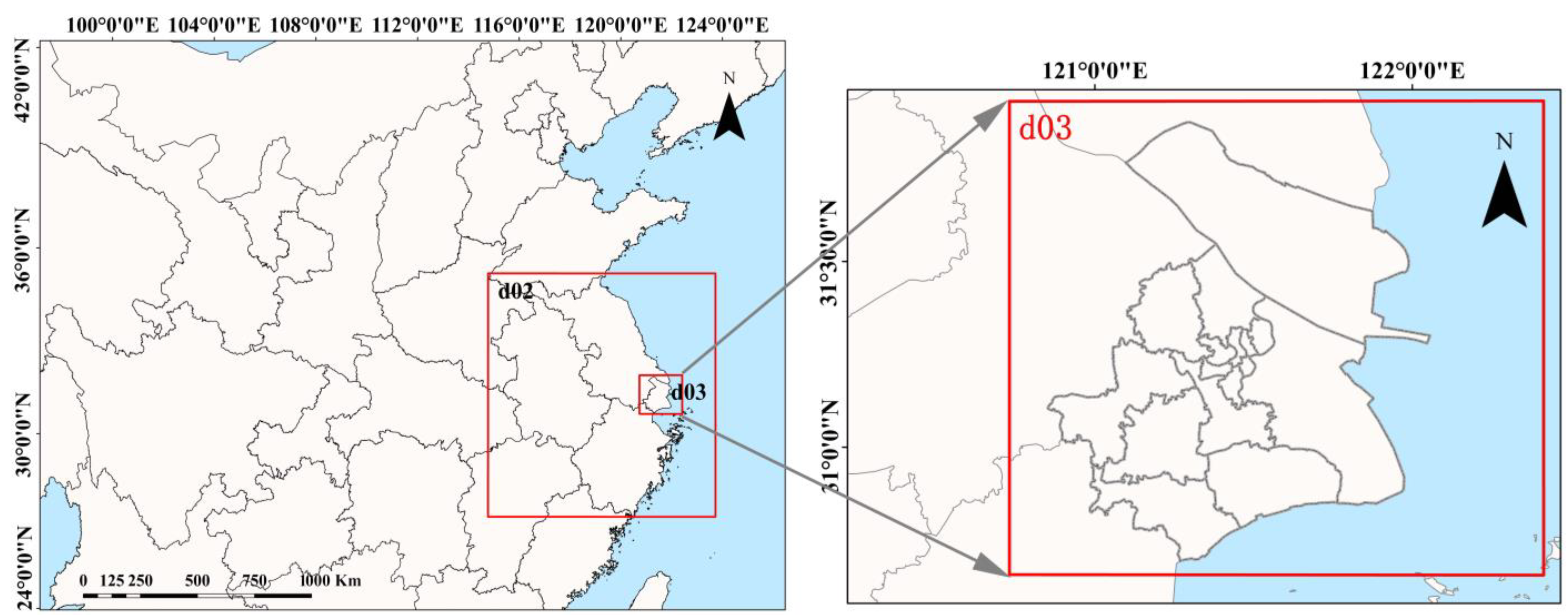
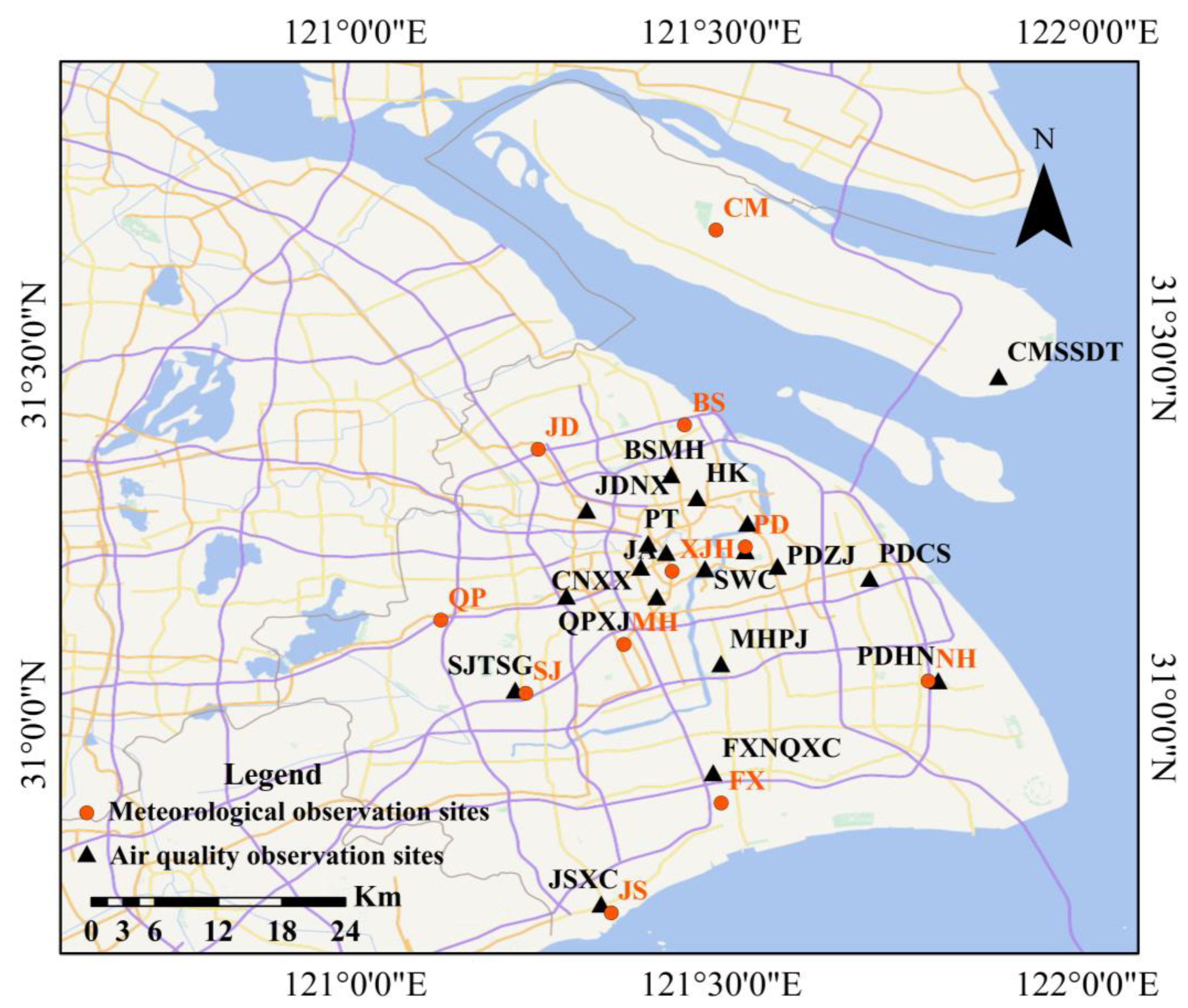
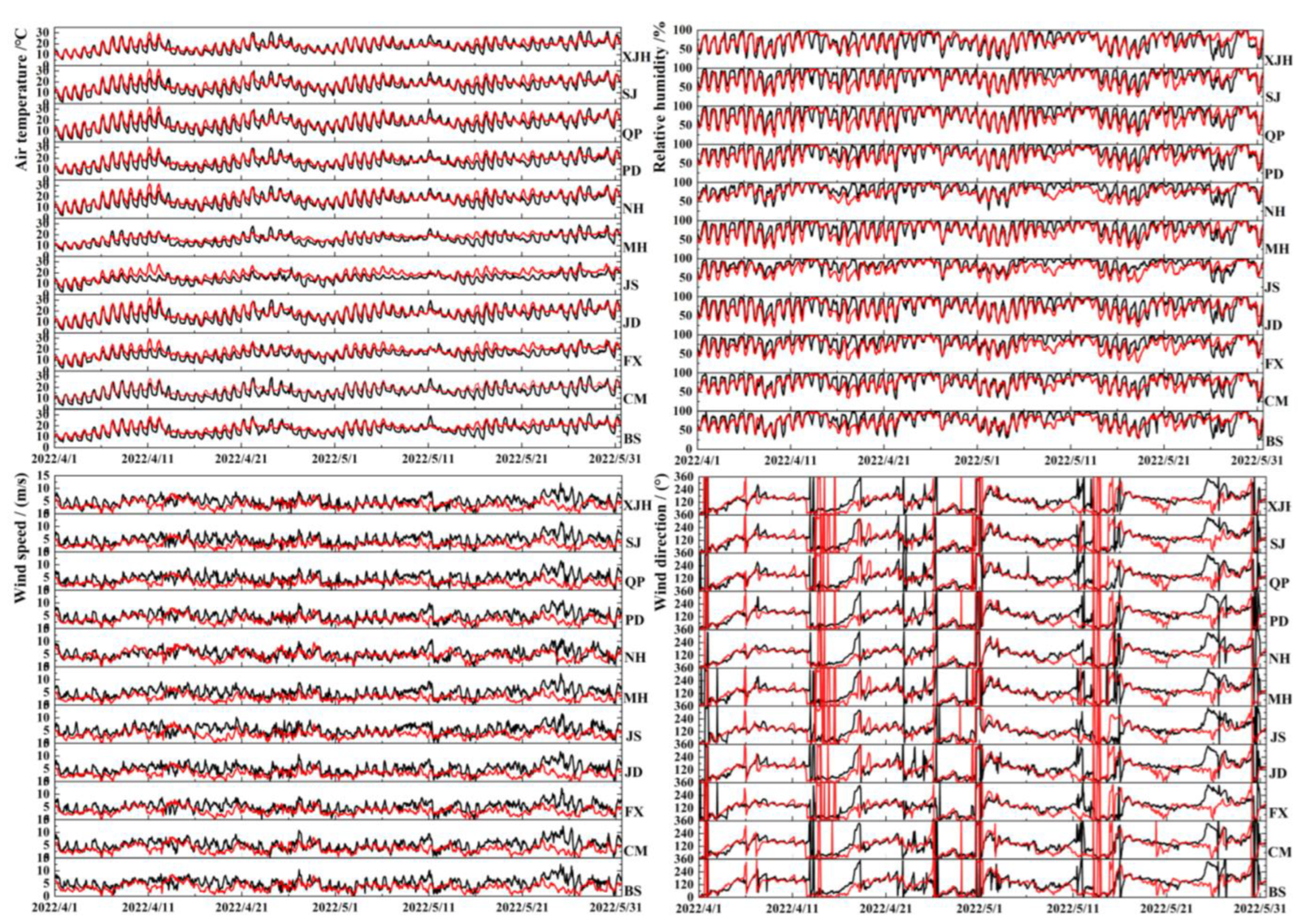

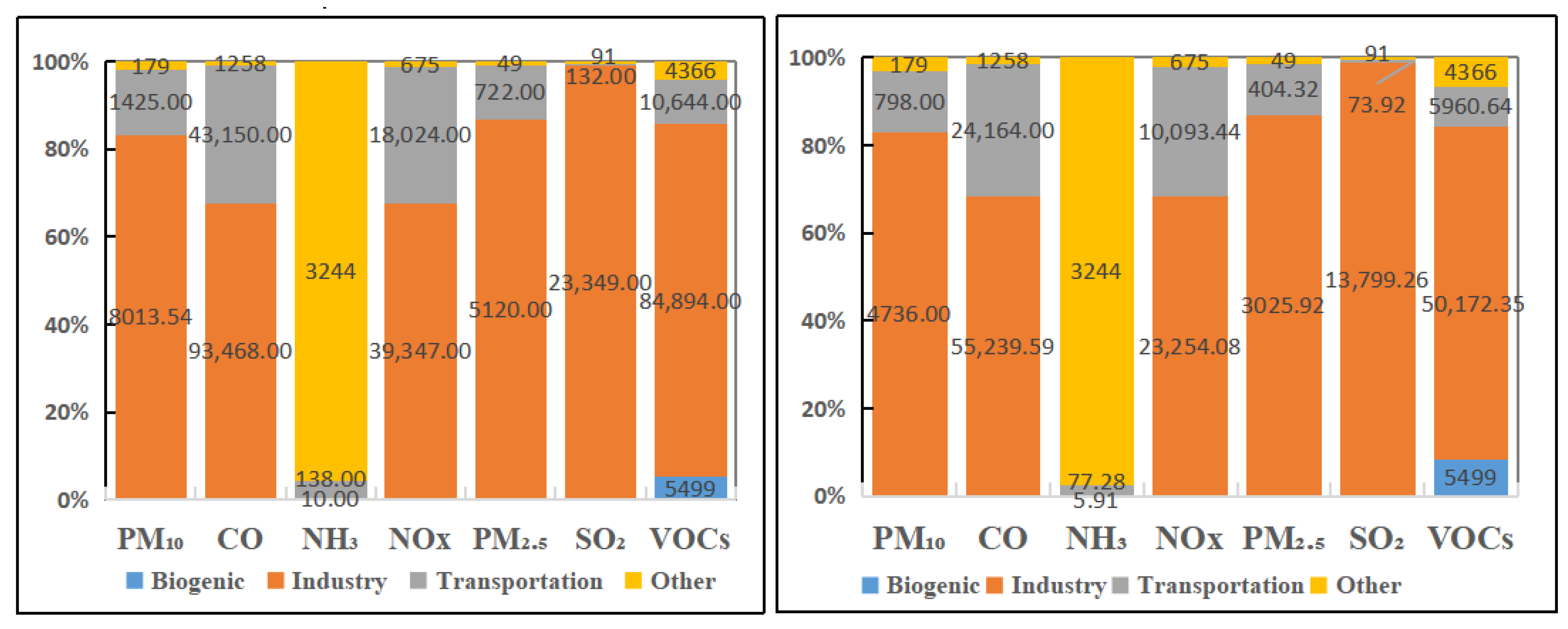

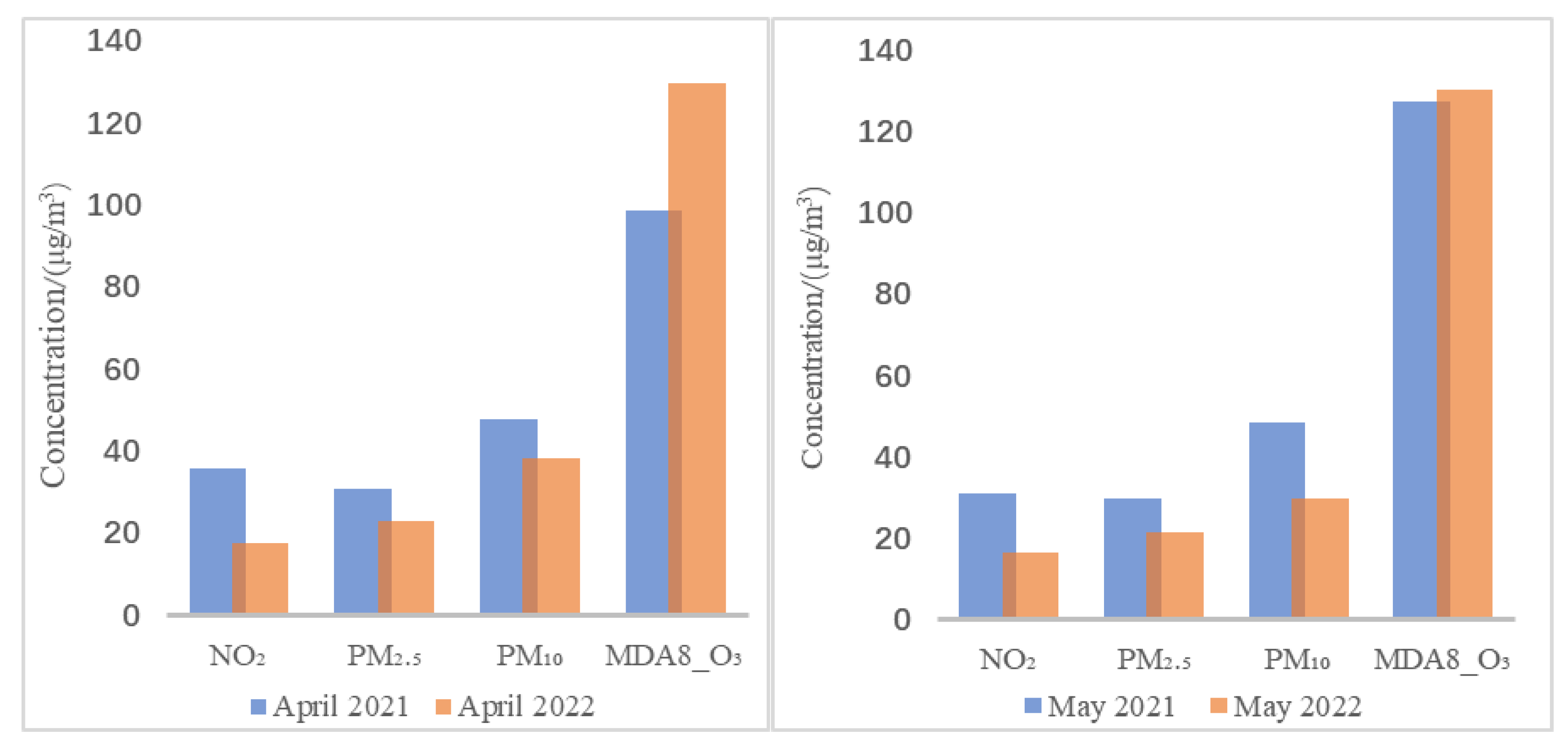

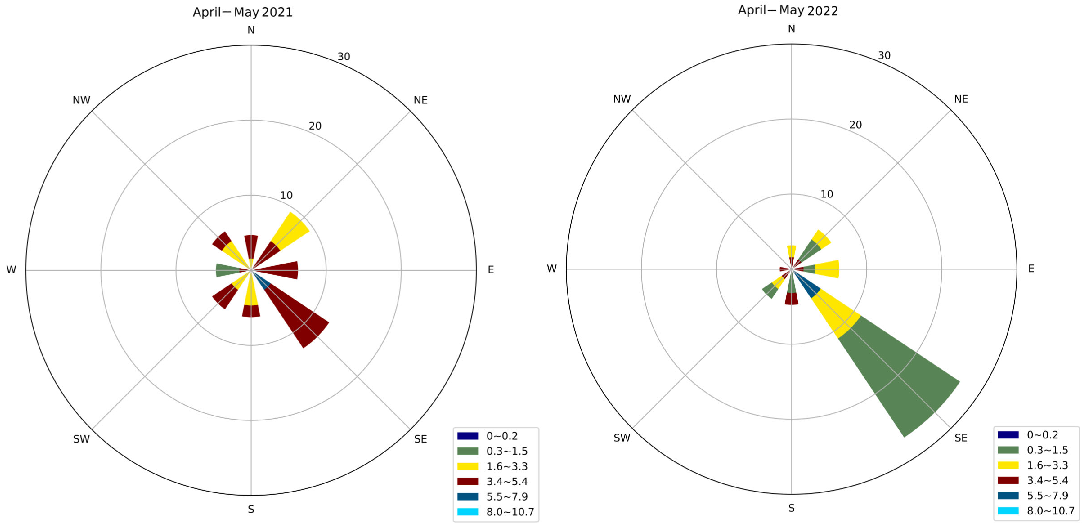
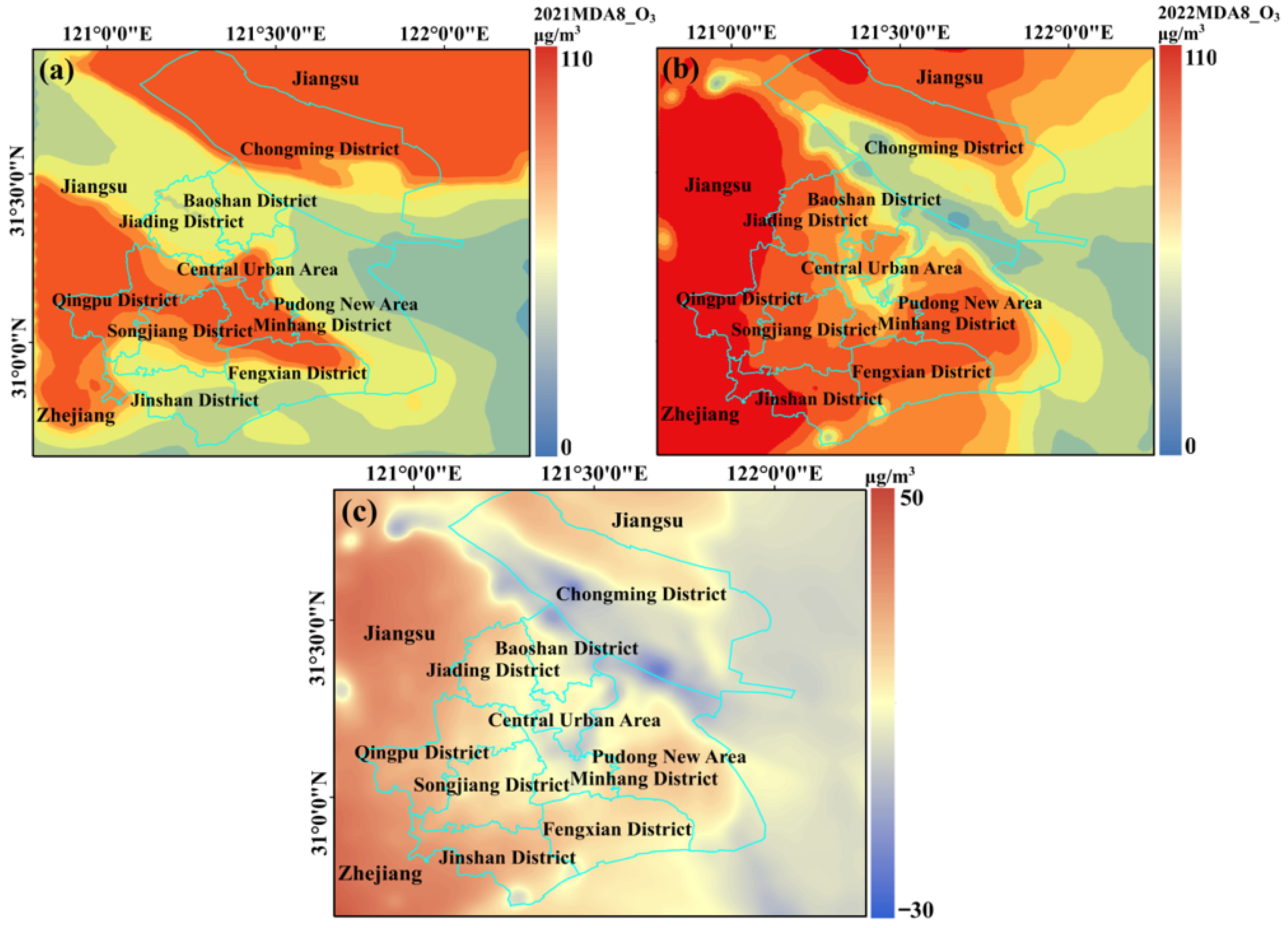
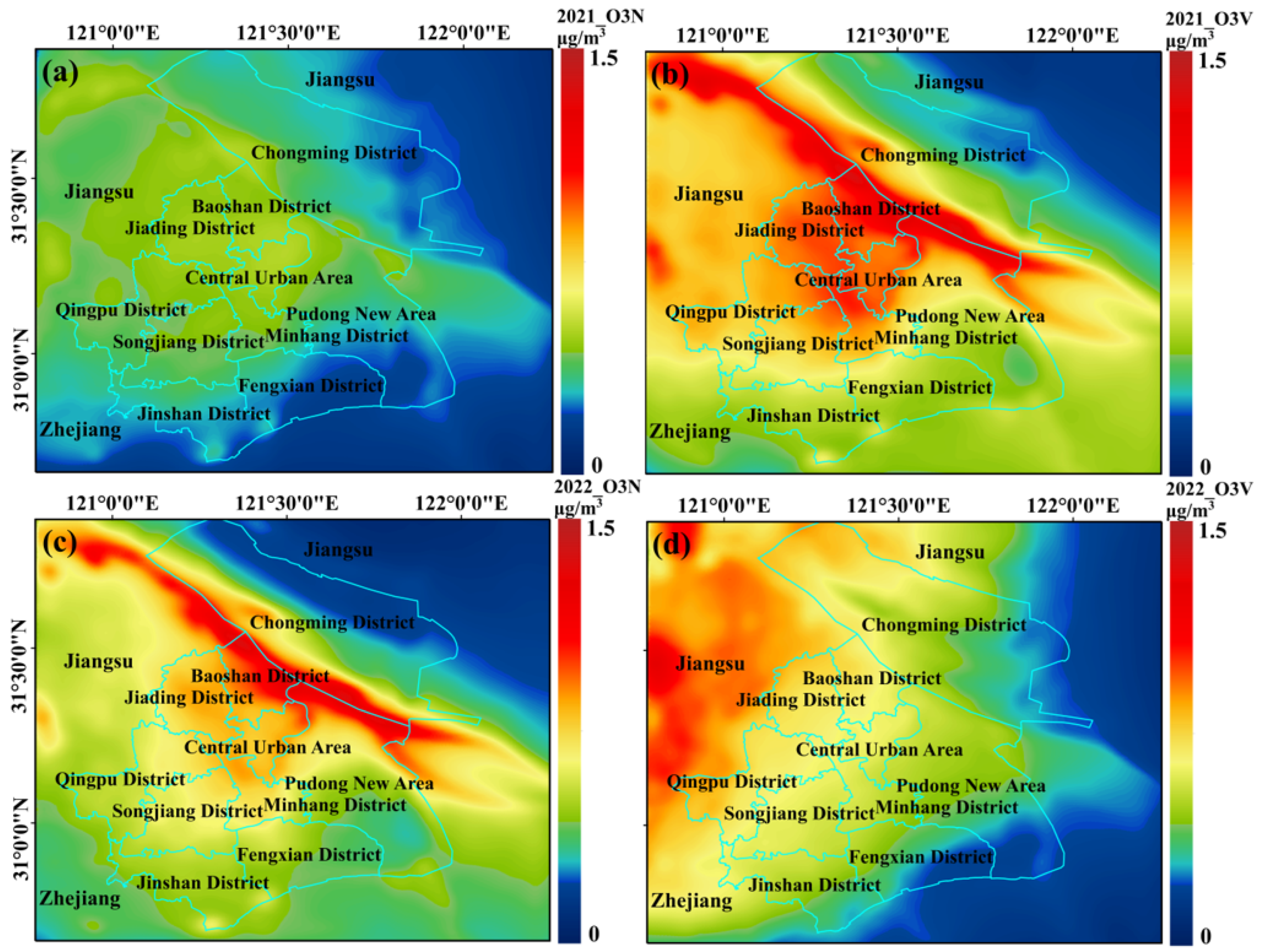

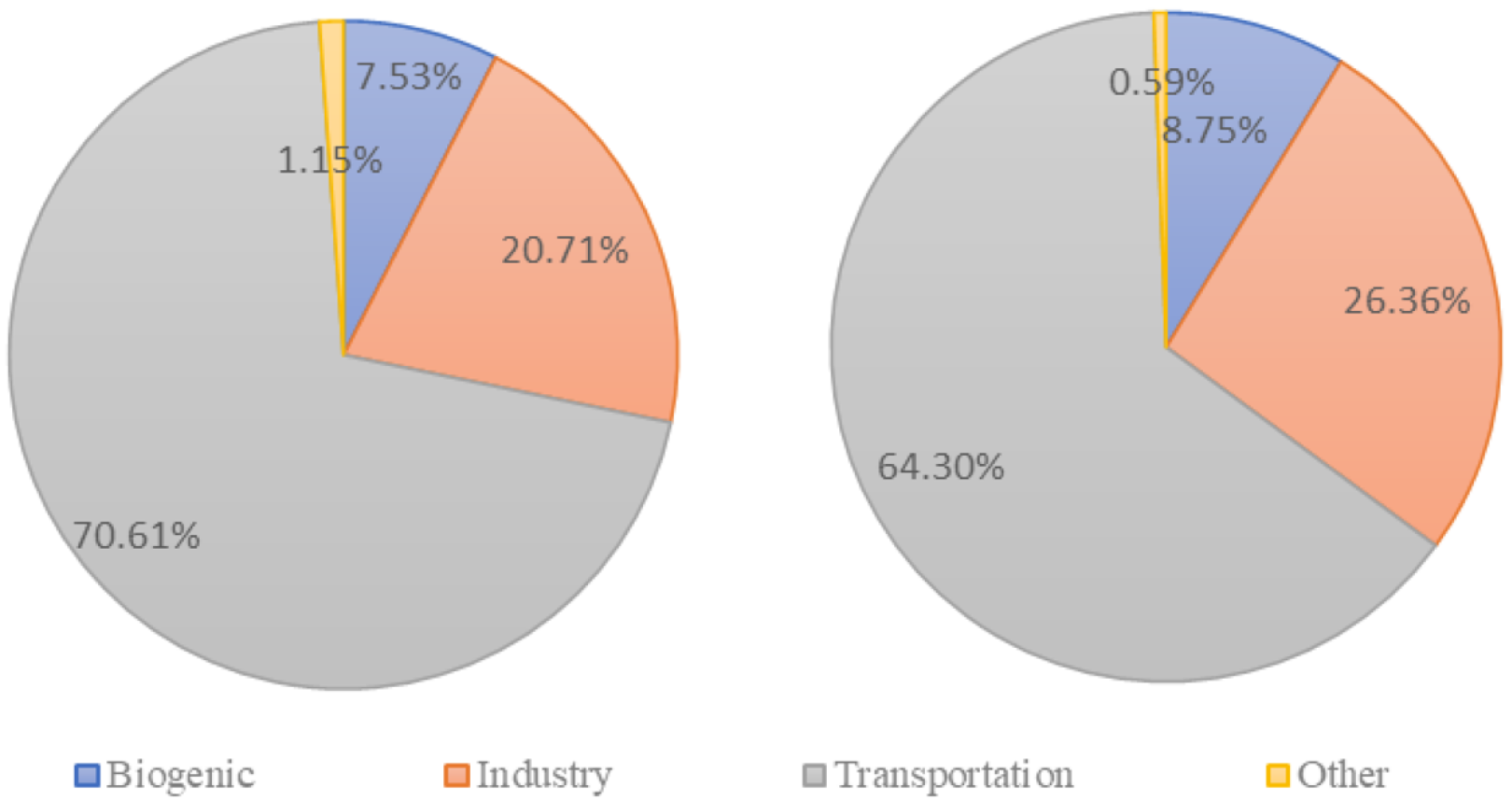
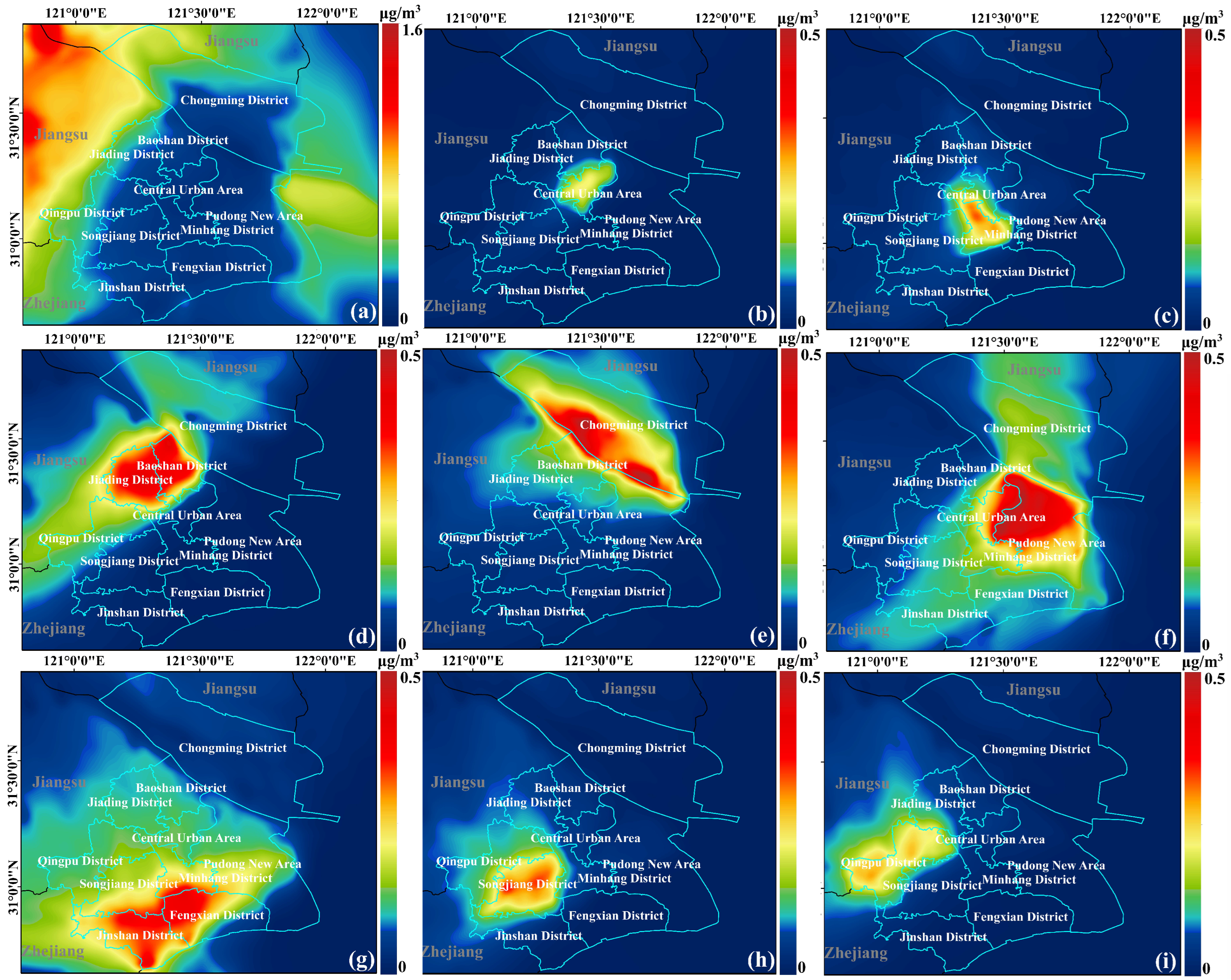


| Temperature/(℃) | Relative Humidity/(%) | Wind Speed/(m/s) | Wind Direction/(°) | ||||||||
|---|---|---|---|---|---|---|---|---|---|---|---|
| MB | RMSE | COR | MB | RMSE | COR | MB | RMSE | COR | MB | RMSE | |
| BS | −0.05 | 3.01 | 0.82 | 3.54 | 14.14 | 0.69 | 0.55 | 2.51 | 0.61 | 10.96 | 65.83 |
| CM | −0.01 | 3.10 | 0.81 | 5.06 | 14.18 | 0.70 | 0.56 | 2.53 | 0.62 | 14.94 | 64.03 |
| FX | −0.09 | 2.52 | 0.82 | 10.35 | 16.45 | 0.67 | 1.58 | 2.45 | 0.68 | 8.49 | 58.44 |
| JD | 0.11 | 3.06 | 0.85 | 6.78 | 15.23 | 0.74 | 0.82 | 2.64 | 0.60 | 12.55 | 62.55 |
| JS | −0.05 | 2.33 | 0.81 | 9.39 | 14.92 | 0.65 | 0.76 | 2.64 | 0.65 | 4.82 | 71.47 |
| MH | −0.01 | 2.94 | 0.84 | 7.28 | 15.00 | 0.73 | 0.87 | 2.61 | 0.61 | 12.65 | 59.63 |
| NH | −0.03 | 2.82 | 0.78 | 6.75 | 15.03 | 0.57 | 0.68 | 2.19 | 0.70 | 15.05 | 61.71 |
| PD | −0.10 | 3.01 | 0.83 | 6.70 | 15.27 | 0.69 | 0.30 | 2.32 | 0.54 | 11.09 | 61.15 |
| QP | −0.09 | 3.19 | 0.84 | 7.30 | 15.22 | 0.75 | 0.72 | 2.56 | 0.58 | 11.01 | 59.21 |
| SJ | −0.06 | 3.07 | 0.83 | 7.49 | 15.15 | 0.73 | 0.77 | 2.55 | 0.60 | 7.17 | 73.10 |
| XJH | −0.04 | 2.99 | 0.82 | −2.42 | 14.60 | 0.71 | 0.45 | 2.37 | 0.63 | 13.72 | 61.25 |
| Stations | Pollutants | /(μg/m3) | MB/(μg/m3) | RMSE/(μg/m3) | COR/(μg/m3) |
|---|---|---|---|---|---|
| BSMH | PM2.5 | 24.63 | 3.82 | 24.26 | 0.57 |
| NO2 | 13.38 | −3.11 | 15.31 | 0.52 | |
| SO2 | 7.18 | −1.89 | 5.17 | 0.50 | |
| MDA8 O3 | 97.01 | −21.08 | 45.26 | 0.54 | |
| FXNQXC | PM2.5 | 22.28 | 4.44 | 26.67 | 0.56 |
| NO2 | 16.48 | −8.58 | 14.32 | 0.54 | |
| SO2 | 6.25 | −1.56 | 4.92 | 0.56 | |
| MDA8 O3 | 100.88 | −21.86 | 45.72 | 0.52 | |
| HK | PM2.5 | 21.20 | 3.65 | 20.57 | 0.53 |
| NO2 | 16.52 | −6.47 | 13.49 | 0.60 | |
| SO2 | 5.51 | 0.10 | 13.49 | 0.60 | |
| MDA8 O3 | 97.84 | −21.93 | 46.64 | 0.52 | |
| JDNX | PM2.5 | 21.92 | 5.78 | 24.74 | 0.51 |
| NO2 | 21.78 | −9.19 | 15.96 | 0.62 | |
| SO2 | 5.23 | −0.002 | 5.58 | 0.55 | |
| MDA8 O3 | 98.40 | −22.93 | 48.65 | 0.58 | |
| JSXC | PM2.5 | 24.20 | 1.56 | 29.90 | 0.52 |
| NO2 | 17.51 | −9.12 | 16.16 | 0.56 | |
| SO2 | 11.21 | −7.47 | 10.28 | 0.50 | |
| MDA8 O3 | 104.93 | −26.87 | 51.28 | 0.57 | |
| MHPJ | PM2.5 | 17.25 | 1.46 | 20.87 | 0.57 |
| NO2 | 14.94 | −4.18 | 12.99 | 0.59 | |
| SO2 | 4.03 | 0.75 | 5.19 | 0.55 | |
| MDA8 O3 | 95.30 | −13.05 | 40.96 | 0.57 | |
| PDCS | PM2.5 | 22.47 | 6.78 | 24.28 | 0.54 |
| NO2 | 19.90 | −10.47 | 15.57 | 0.53 | |
| SO2 | 4.93 | −0.67 | 4.43 | 0.58 | |
| MDA8 O3 | 105.31 | −26.00 | 47.78 | 0.56 | |
| PDHN | PM2.5 | 22.49 | 7.76 | 25.74 | 0.52 |
| NO2 | 16.27 | −7.67 | 14.16 | 0.52 | |
| SO2 | 4.76 | −0.52 | 3.78 | 0.54 | |
| MDA8 O3 | 92.36 | −11.95 | 39.78 | 0.50 |
Disclaimer/Publisher’s Note: The statements, opinions and data contained in all publications are solely those of the individual author(s) and contributor(s) and not of MDPI and/or the editor(s). MDPI and/or the editor(s) disclaim responsibility for any injury to people or property resulting from any ideas, methods, instructions or products referred to in the content. |
© 2023 by the authors. Licensee MDPI, Basel, Switzerland. This article is an open access article distributed under the terms and conditions of the Creative Commons Attribution (CC BY) license (https://creativecommons.org/licenses/by/4.0/).
Share and Cite
Shen, S.; He, L.; Chen, W.; Chen, S.; Ma, W. Spatial and Temporal Distribution Characteristics of Ozone Concentration and Source Analysis during the COVID-19 Lockdown Period in Shanghai. Atmosphere 2023, 14, 1563. https://doi.org/10.3390/atmos14101563
Shen S, He L, Chen W, Chen S, Ma W. Spatial and Temporal Distribution Characteristics of Ozone Concentration and Source Analysis during the COVID-19 Lockdown Period in Shanghai. Atmosphere. 2023; 14(10):1563. https://doi.org/10.3390/atmos14101563
Chicago/Turabian StyleShen, Shinan, Li He, Wanqi Chen, Shuang Chen, and Weichun Ma. 2023. "Spatial and Temporal Distribution Characteristics of Ozone Concentration and Source Analysis during the COVID-19 Lockdown Period in Shanghai" Atmosphere 14, no. 10: 1563. https://doi.org/10.3390/atmos14101563
APA StyleShen, S., He, L., Chen, W., Chen, S., & Ma, W. (2023). Spatial and Temporal Distribution Characteristics of Ozone Concentration and Source Analysis during the COVID-19 Lockdown Period in Shanghai. Atmosphere, 14(10), 1563. https://doi.org/10.3390/atmos14101563





